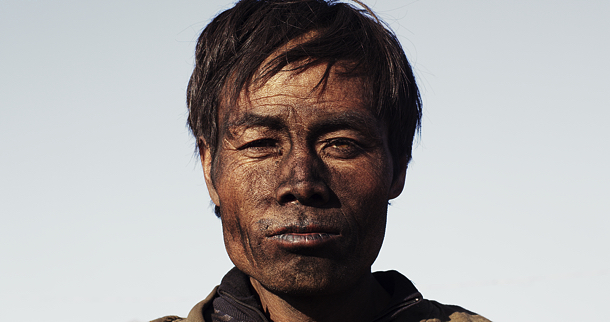

Director: Liang Zhao | Cast: Liang Zhao, Sylvie Blum Fabrice Rouaud | Doc| France | China
Herdsman and their families make way for machines of natural destruction in this poetic rumination on the industrial ravaging of Inner Mongolia.
The transformation of paradise into purgatory, with hell firmly in sight, gets imposing visual treatment in Chinese filmmaker Zhao Liang’s Behemoth. This image-based hybrid of documentary and poetic allegory is a plaintive account of the rape of the earth by coal mining companies in the Inner Mongolian grasslands, and of the dehumanizing existence of local and Chinese migrant workers. Alternating between grimly beautiful passages and others that, frankly, are dull and dutiful, this is a rigorous exercise with something of a trance quality, which builds to a forceful payoff at the end.
Scheduled to air on French cultural network Arte in November, the film should travel from its Venice premiere to other festivals, while its elements of performance art interspersed with industrial horror might also work in museum spaces.
Zhao and his French co-writer (and producer) Sylvie Blum draw inspiration from Dante’s Divine Comedy, beginning with the image of a massive rock crater ruptured by explosions that send clouds of black coal dust billowing into the atmosphere. Zhao’s introductory voiceover explains that where once there was lush vegetation and mountain springs, now not even a blade of grass grows in these flattened valleys of gray.
Gorgeous pastoral sequences show sheep grazing; Zhao then widens that view to reveal the steady shrinkage of pastureland. Traditional rural workers are displaced, while more and more mountains are reduced to rubble, and prairies are buried beneath ash. Observing with unblinking indignation, his camera gazes down on a valley crawling with trucks, cranes and other machines that look like toys, belching out smoke. “The monster’s playthings” is how Zhao describes them in his intermittent narration, adopting a dreamy, ponderous tone that can get a bit precious.
At certain points you start to wonder how long we can continue looking at workers sifting or shoveling rocks. But then the focus shifts to stirring close-ups of their emotionless faces and black-rimmed eyes, every pore and line caked with coal dust, which Zhao descriptively calls “inky makeup.” He observes them scouring their skin to remove the grime before sitting down to a bowl of soup. In one especially expressive shot, a naked baby boy industriously scrapes away at the ground around him with a stick, as if programmed by instinct to prepare for his future. No commentary is required to note the juxtaposition of extremely basic living conditions against an industry generating huge profits.
In the film’s most strikingly cinematic section the screen turns to red as Zhao’s camera enters the nearby ironworks. The staggering heat and intensity of the furnaces is palpable, and the baked faces of workers stream with sweat as the cacophonous noise of the machinery gives way to deafened silence when they exit on breaks. Zhao’s words perhaps overstate the theme of a living hell fueled by greed, but there’s nothing prosaic about the inferno-esque images.
The most unsettling passages of Behemoth show the heavy toll of this life on the alarming number of workers battling lung disease, denied aid by both their industrial overlords and their government. And the film moves toward a conclusion of grave lyricism in which Zhao reveals the paradox of all this human drudgery and environmental violation helping to create pristine but empty clusters of apartment towers in urban satellite centers. The destruction of a natural paradise has yielded luxury graveyards, transformed into “ghost cities” by the burst development bubble.
Shot over a two-year period, Zhao’s film makes lucid points about the dire consequences of relentless energy and fuel consumption. Like the narration, some touches are self-consciously arty — a naked figure in fetal position seen repeatedly in places where grassland meets scorched earth; the screen broken into prismatic fragments that suggest an industrial cathedral; a literal mirror held up to show our collective responsibility. But even if those elements seem too studied, the subtle impact of this contemplative documentary can’t be denied.